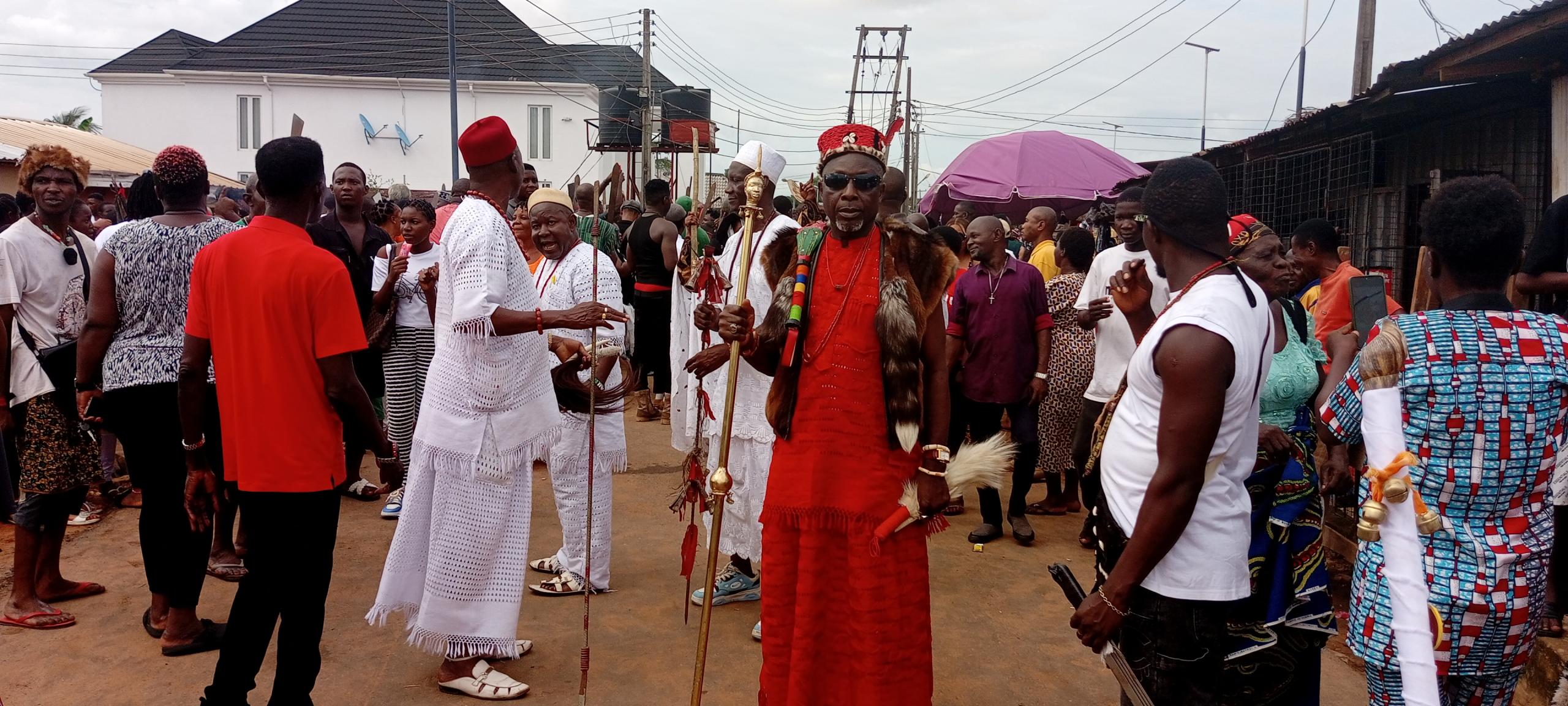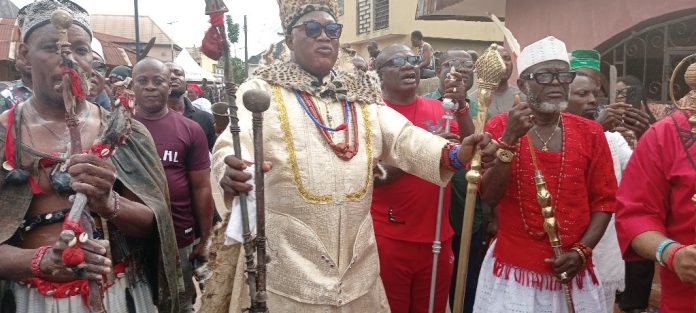
UMUAGU quarters has paid homage to the Odogwu of Asaba, Obi Nwanze Oduah.
It was during the Ine festival. Every year, in the beginning of October, the Asaba people go to the streets to celebrate Ine. This year was not different, as the youths filled the streets in a charged atmosphere to celebrate the heroics of ancient Asaba.
During the celebration, the people displayed different comic characters to showcase the festival in grand style. Some appeared in small, plain white fabrics called Akwa-Ocha covering their waist with a white feather strapped to their head. Others were in red attires, carrying clay pots, while the youths rubbed their bodies with white native chalk called “Nzu and wielding machetes. These characters were beautiful dancers and entertainers.
During the procession, Obi Ibeagbunam Isichie and the Ogbus, led the Umuagu war orchestra and followers to behold the Odogwu of Ahaba, Obi Nwanze Oduah, as part of the Ine Ahaba ritual dance. They also moved around the villages in large gatherings to dance and celebrate the end of the farming season and the Ine festival.
The celebration kicked off from the Ogwa of Umuagu down to the sacred Umuagu altar before heading to the Odogwu’s traditional home.
During the ceremony, the Obi performed certain rituals in front of his apartment in Umuagu with the ebos to cleanse the land and offer sacrifices in appreciation to the gods of their land.
According to him, “Asaba culture is beautiful and unique. People without a culture are lost because culture is a way of life. Our culture manifests in our kind of food, attire, dance styles, house designs, and our festivals. He added that the Asaba cultural heritage needs to be preserved to prevent the loss of cultural knowledge and collective memories of the past.
He further noted that cultural heritage has become part of the life and livelihoods of the people, as elements of cultural homogeneity lie within people’s lives and livelihoods.
“The beauty of the Ine is that it showcases the rich cultural identity and heritage of the Asaba people.”
For the people of Asaba community, this year’s annual Ine festival will not be forgotten in a hurry, as it was filled with merriment and excitement for indigenes as they danced joyfully.”
The Ine happens to be the outing of warlords to showcase the traditional culture of Asaba.
At the Odogwu’s residence, the red cap chiefs and followers screamed with excitement and danced with him from the inner chambers of his ancestral home to receive the large crowd and the Umuagu Ebos (Warlords), who came out in large numbers, displaying excitement and applause as they danced and sang to the sound of the big wooden gong.
At this point, the fully charged Odogwu, in war mood, became softened to receive the Ebos and to display the “Egwu Otta” dance before the waiting crowd.
As he stepped onto the grounds with the chief priest and other red cap chiefs, the people beheld him, shouting “Odogwu abiii! Odogwu abii!” with excitement danced with him from the inner chambers of his ancestral home to receive the large crowd.
Meanwhile, the women and youths of Umuagu showcased caricature looks, with different comic characters, shaking their bodies to the sound of the drum to celebrate the Ine.
The Odogwu of Asaba, Obi Nwanze Oduah, well dressed as a warlord with various traditional beads decorated on his attire, in his traditional home in Asaba, said that the Ine is indeed the climax of the annual New Yam celebration.
According to him, the festival is an opportunity for the warriors (the Ogbus) and able-bodied men to show off their military prowess, demonstrating their readiness to defend their land and thank God Almighty for preserving their people.
He disclosed that the Ine is a period of happiness, adding that consequently, burials and mournings were not permitted, hence, the suspension of burial ceremonies in Asaba until after the annual traditional festivals, from August to the middle of October. The Ine is one memorable event that will not be forgotten in a hurry, considering the peace and harmony that comes with the celebration.
The Odogwu, in his traditional home in Asaba, reiterated that the Ine is indeed the climax of the annual New Yam celebration.
He maintained that although the festival is generally led by the Ogbus and the Otu-Ihaza, the womenfolk also participated actively in recognition of the important roles they played during wars as home keepers.
According to him, the Iyase and the Odogwu are the principal warlords of Asaba, the custodians of Asaba people’s Ikenga (Guardian Spirit) and the deity of war, which makes the festival very colourful and vibrant. They also represent Asaba people’s efforts to avoid the total eclipse of their traditional and cultural heritage in the face of eroding Western cultural influences and values. The highpoint of the ceremony was the royal dancee of Okanga, displayed by the Odogwu facing the warlords of Umuagu, as the youths and women of Umuagu danced joyfully, jubilating at the displays of the Odogwu and exchanging swords to the sound of the drum.


